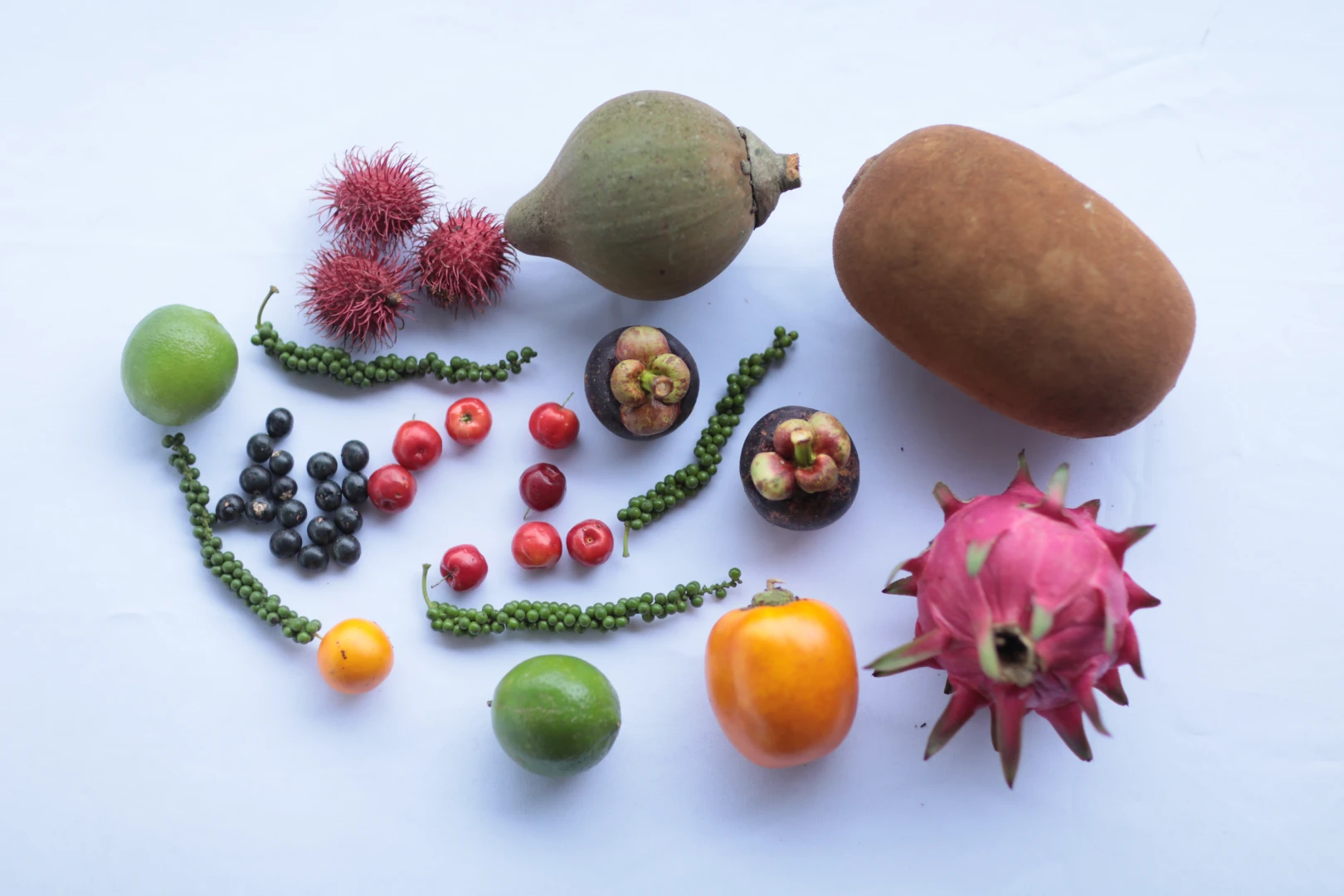
Amazonian Superfruits: Health Benefits, Sustainability, and Culinary Magic from the Rainforest
The Amazon rainforest’s superfruits—açaí, cupuaçu, camu camu, cocona, and buriti (aguaje)—are nature’s ultimate wellness allies, blending unparalleled nutrition with vibrant flavors. Bursting with antioxidants, vitamins, and rare phytochemicals, these fruits fuel global kitchens, from Michelin-starred menus to health-conscious smoothie bowls. Açaí’s anthocyanins boost athletic recovery, camu camu’s vitamin C dwarfs oranges, and buriti (known as aguaje in Peru) offers beta-carotene for glowing skin. Sourced sustainably through fair-trade partnerships with Amazonian communities, superfruit purees like Campodrim’s deliver rainforest vitality to modern plates. Discover how these treasures support holistic health, honor Indigenous traditions, and redefine sustainable gastronomy—one spoonful at a time.
The Rainforest Pantheon – Superfruits Unveiled
Açaí (Euterpe oleracea)
Açaí, the dark purple jewel of the Amazon, is celebrated for its dense concentration of anthocyanins, antioxidants that outshine blueberries threefold. These compounds combat oxidative stress, making it a favorite among athletes for post-workout recovery. Traditionally, Amazonian riverine communities pair açaí with fish or tapioca during harvest festivals, honoring its role as both sustenance and cultural symbol. Today, frozen açaí purees power modern smoothie bowls and energy bars, bridging ancient rituals and contemporary nutrition.
Cupuaçu (Theobroma grandiflorum)
With a flavor reminiscent of pineapple, banana, and chocolate, cupuaçu is a sensory masterpiece. Its pulp boasts 40% of the daily recommended vitamin C per serving, alongside theograndins—rare antioxidants linked to reduced inflammation. Revered by the Tupi-Guarani people as the “fruit of the gods,” cupuaçu was historically used in sacred ceremonies. Now, ambient-stable purees lend its creamy tang to vegan mousses, salad dressings, and tropical cocktails, proving tradition can thrive in modern kitchens.
Camu Camu (Myrciaria dubia)
Camu camu reigns as nature’s ultimate vitamin C powerhouse, packing 60 times the concentration of oranges. Indigenous shamans once relied on its bright, tart berries to ward off illness during the rainy season. Today, its puree adds a zesty punch to fermented foods like kombucha and immunity-boosting mocktails, offering a tangy nod to its medicinal roots.
Cocona (Solanum sessiliflorum)
Cocona, a tangy tomato-like fruit, is iron-rich and brimming with B vitamins essential for energy metabolism. In Andean folklore, it symbolizes vitality, often featured in stories of endurance. Modern chefs harness its acidity in ceviche, chutneys, and cocktails, while frozen purees make it accessible far beyond its native highland forests.
Buriti/Aguaje (Mauritia flexuosa)
Known as aguaje in Peru, buriti’s vibrant orange pulp contains 15 times more beta-carotene than carrots, supporting skin and eye health. Dubbed the “tree of life,” its fruit, fiber, and oil are woven into Indigenous crafts, food, and traditional medicine. Ambient purees now infuse plant-based cheeses and soups with its golden hue, connecting Amazonian heritage to global culinary innovation.
Nutritional Superpowers – Science Meets Tradition
| Superfruit | Key Nutrients | Health Benefits |
|---|---|---|
| Açaí | Anthocyanins, Omega-9s | Reduces oxidative stress, supports heart health |
| Cupuaçu | Theograndins, Vitamin C | Anti-inflammatory, boosts skin collagen |
| Camu Camu | Vitamin C, Ellagic Acid | Strengthens immunity, improves gut health |
| Cocona | Iron, B Vitamins | Enhances energy, regulates blood sugar |
| Buriti/Aguaje | Beta-carotene, Omega-9s | Supports vision, skin elasticity |
Açaí: A 2018 study in the Journal of Agricultural and Food Chemistry found that athletes consuming açaí pulp saw a 30% reduction in oxidative stress markers post-exercise. Its omega-9 fatty acids, akin to olive oil, support cardiovascular health—a benefit Indigenous communities have leveraged for centuries.
Camu Camu: A 2020 trial in Nutrients demonstrated that elderly participants taking camu camu supplements experienced 50% fewer colds. Its ellagic acid, a natural antimicrobial, aligns with shamans’ historical use to combat infections.
Cupuaçu: Research in Food & Function highlights cupuaçu’s theograndins as natural anti-inflammatories, rivaling synthetic drugs without side effects. Paired with vitamin C, it also stimulates collagen production, a secret behind Amazonian skin resilience.
Culinary Innovation – From Rainforest to Plate
Savory Creations
Cocona Ceviche: Marinate fresh seabass in Campodrim’s frozen cocona puree, diced red onion, and ají amarillo paste. The fruit’s acidity tenderizes the fish while delivering iron and B vitamins.
Buriti-Infused Golden Soup: Blend roasted butternut squash with Campodrim’s ambient buriti puree for a beta-carotene-rich soup with a nutty sweetness.
Sweet Masterpieces
Cupuaçu-White Chocolate Mousse: Whip coconut cream with Campodrim cupuaçu puree and vegan white chocolate for a dessert balancing creaminess and tropical acidity.
Açaí Energy Bites: Combine rolled oats, almond butter, and Campodrim frozen açaí puree for anthocyanin-packed snacks.
Beverage Alchemy
Camu Camu Immunity Fizz: Shake Campodrim camu camu puree with ginger syrup and sparkling water for a vitamin C powerhouse.
FAQ
What are the best Amazonian superfruits for boosting immunity and skin health?
Açaí (anthocyanins), camu camu (vitamin C), and buriti (beta-carotene) lead the pack.
What makes camu camu a better vitamin C source than synthetic supplements?
Its vitamin C is naturally paired with ellagic acid for enhanced absorption, reducing cold frequency by 50% in clinical trials.
How does agroforestry farming protect the Amazon when growing superfruits?
Agroforestry retains 90% of native vegetation vs. 30% in monocultures, safeguarding habitats for endangered species like harpy eagles.
How do Amazonian superfruits compare to other superfoods like blueberries?
Açaí has 3x more anthocyanins than blueberries, while camu camu’s vitamin C dwarfs citrus.
A Future Rooted in the Rainforest
Amazonian superfruits are more than ingredients—they are a testament to nature’s ingenuity and human resilience. By choosing ethically sourced purees, we honor Indigenous wisdom, protect biodiversity, and invest in a food system where every spoonful supports both people and planet. To explore sustainably sourced superfruit purees, visit Campodrim’s website.